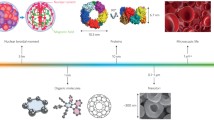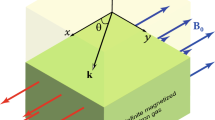Abstract
The time-dependent Schrödinger equation is developed for a spinless electron which is confined to move on a toroidal surface and curvature effects are taken into account. The electron motion is driven by linearly or circularly polarized microwaves including an interference field. To calculate the magnetic moments which are induced by the electronic surface currents on the torus an eight-state basis set is used. The system is driven at a resonance frequency to allow for transitions between states with opposite θ-parity. Optical transitions into modes of excitation can be observed that correspond to a magnetic dipole term parallel to the toroidal central symmetry axis as well as additional components in radial and azimuthal direction (solenoidal modes). Size and relative magnitude of the different components can be steered by adjusting magnitude, polarization, and phase information of the microwave field. Substantial enhancements of the solenoidal magnetic modes versus the dipole mode can be observed when adding a sufficiently strong static magnetic field parallel to the symmetry axis.
Similar content being viewed by others
References
Shapiro M., Brumer P. (2003) Principles of the Quantum Control of Molecular Processes. John Wiley & Sons, Hoboken, NJ
Borzi A., Stadler G., Hohenester U. (2002) Optimal quantum control in nanostructures: Theory and application to a generic three-level system. Phys. Rev. A 66, 053811–6
Pötz W. (1998) Coherent control of terahertz radiation from semiconductor nanostructures. Appl. Phys. Lett. 72, 3002–3004
Qin H., van der Weide D.W., Truitt J., Eberl K., Blick R.H. (2003) Electron dynamics of an artificial atom probed by pulsed microwave spectroscopy. Nano. 14, 60–64
Oosterkamp T.H., Fujisawa T., van der Wiel W.G., Ishibashi K., Hijman R.V., Tarucha S., Kouwenhoven L.P. (1998) Microwave spectroscopy on a quantum-dot molecule. Nature 395, 873–876
Pershin Y.V., Piermarocchi C. (2005) Laser-controlled local magnetic field with semiconductor quantum rings. Phys. Rev. B 72, 245331–5
Pershin Y.V., Piermarocchi C. (2005) Persistent and radiation-induced currents in distorted quantum rings. Phys. Rev. B 72, 125348–7
Sasaki K., Kawazoe Y., Saito R. (2004) Aharonov-Bohm effect in higher genus materials. Phys. Lett. A 321, 369–375
Sasaki K., Kawazoe Y., Saito R. (2004) Fractional flux periodicity in tori made of square lattice. Prog. Theor. Phys. 112,369–382
Simonin J., Proetto C.R., Barticevic Z., Fust G. (2004) Single-particle electronic spectra of quantum rings: A comparative study. Phys. Rev. B. 70, 205305–8
Viefers S., Koskinen P., Singha Deo P., Manninen M. (2004) Quantum rings for beginners: Energy spectra and persistent currents. Physica E. 21(1): 1–35
Encinosa M., Lonnie Mott L. (2003) Curvature-induced toroidal bound states. Phys. Rev. A 68, 014102–4
Encinosa M., Mott L., Etemadi B. (2005) Wave functions in the neighborhood of a toroidal surface; Hard vs. Soft constraint. Phys. Scr. 72, 13–15
Garcia J.M., Medeiros-Ribeiro G., Schmidt K., Ngo T., Feng J.L., Lorke A., Kotthaus J., Petroff P.M. (1997) Intermixing and shape changes during the formation of InAs self-assembled quantum dots. Appl. Phys. Lett. 71, 2014–2016
Lorke A., Böhm S., Wegscheider W. (2003) Curved two-dimensional electron gases. Superlattices Micro. 33, 347–356
Lorke A., Luyken R.J., Govorov A.O., Kotthaus J.P., Garcia J.M., Petroff P.M. (2000) Spectroscopy of Nanoscopic Semiconductor Rings. Phys. Rev. Lett. 84, 2223–2226
Zhang H., Chung S.W., Mirkin C.A. (2003) Fabrication of Sub-50-nm solid-state nanostructures on the basis of Dip-Pen nanolithography. Nano Lett. 3, 43–45
Encinosa M., Jack M. (2006) Elliptical tori in a constant magnetic field. Phys. Scr. 73, 439–442
Burgess M., Jensen B. (1993) Fermions near two-dimensional surfaces. Phys. Rev. A 48, 1861–1868
Jensen H., Koppe H. (1971) Quantum mechanics with constraints. Ann. Phys. 63, 2586–2591
da Costa R.C.T. (1981) Quantum mechanics of a constrained particle. Phys. Rev. A 23, 1982–1987
da Costa R.C.T. (1982) Constraints in quantum mechanics. Phys. Rev. A 25, 2893–2900
Matsutani S. (1992) Path integral formulation of curved low dimensional space. J. Phys. Soc. Jap. 61, 55–63
Goldstone J., Jaffe R.L. (1992) Bound states in twisting tubes. Phys. Rev. B 45, 14100–14107
Exner P., Seba P. (1989) Bound states in curved quantum waveguides. J. Math. Phys. 30, 2574–2580
Schuster P.C., Jaffe R.L. (2003) Quantum mechanics on manifolds embedded in Euclidean space. Ann. Phys. 307, 132–143
Encinosa E. (2006) Coupling curvature to a uniform magnetic field: An analytic and numerical study. Phys. Rev. A 73, 012102–6
Encinosa, M., Jack, M.: Excitation of surface dipole and solenoidal modes on toroidal, arXive:physics/0604214. Photon. Nanostruct (submitted)
Encinosa, M.: A note regarding Gram-Schmidt states on T 2, arXive:physics/0501161
Author information
Authors and Affiliations
Corresponding author
Rights and permissions
About this article
Cite this article
Encinosa, M., Jack, M. Dipole and solenoidal magnetic moments of electronic surface currents on toroidal nanostructures. J Computer-Aided Mater Des 14, 65–71 (2007). https://doi.org/10.1007/s10820-006-9036-7
Published:
Issue Date:
DOI: https://doi.org/10.1007/s10820-006-9036-7
Keywords
- Torus surface
- Static magnetic field
- Curvature potential
- Surface currents
- Microwave radiation
- Magnetic moment
- Dipole mode
- Solenoidal mode




